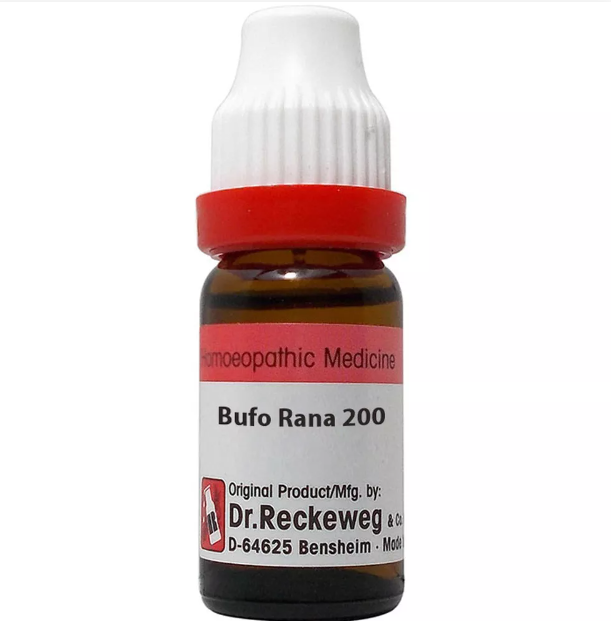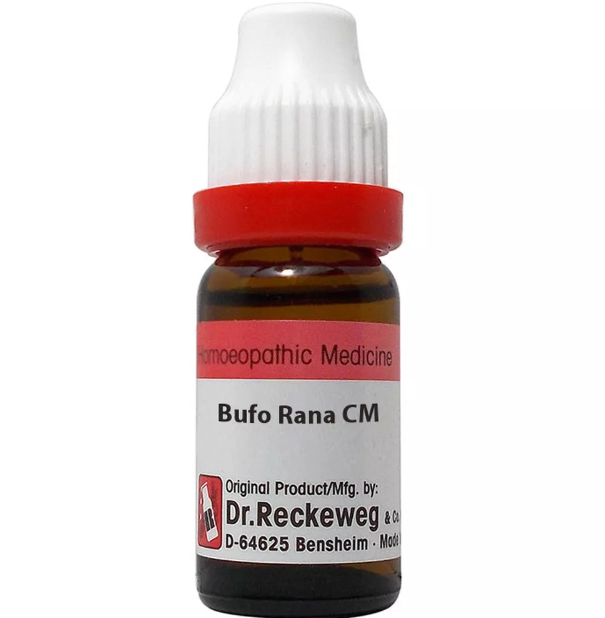BUFO RANA 6C, 12C, 30C, 200C, 1M, 10M USES AND SYMPTOMS
 Bufo rana, commonly known as the poison of the toad, is a homeopathic remedy primarily acting on the nervous system and skin. It is indicated for various conditions, including uterine symptoms, lymphangitis of septic origin, symptoms of paralysis agitans (Parkinson’s disease), and striking rheumatic symptoms.
Bufo rana, commonly known as the poison of the toad, is a homeopathic remedy primarily acting on the nervous system and skin. It is indicated for various conditions, including uterine symptoms, lymphangitis of septic origin, symptoms of paralysis agitans (Parkinson’s disease), and striking rheumatic symptoms.
Psychologically, Bufo rana is associated with arousing the lowest passions, causing a desire for intoxicating drinks, and inducing impotence. It is also noted for its usefulness in feeble-minded children, those prematurely senile, and those exhibiting epileptic symptoms. Convulsive seizures during sleep, particularly at night, are also within its sphere of action, often linked with disturbances of the sexual sphere.
Mind: Individuals needing Bufo rana may exhibit anxiety about health, sadness, restlessness, and a propensity to bite. They can display behaviors such as howling, impatience, nervousness, and a tendency towards imbecility. Desire for solitude and feeble-mindedness are also common mental characteristics.
Head: Sensations in the head include feeling as if hot vapor rises to the top, numbness of the brain, and sweating of the face. Epistaxis (nosebleeds) with flushed face and forehead pain, relieved by the bleeding, is also noted.
Eyes: Intolerance to bright objects and the formation of little blisters on the eyes are characteristic.
Ears: Individuals may find music unbearable, and every little noise might distress them.
Male: Symptoms may include involuntary emissions, impotence, quick discharge during coition, and spasms. There could be buboes and a disposition to handle organs, with effects of onanism.
Female: Bufo can be indicated for various menstrual issues like early and copious periods, clots, metrorrhagia, and watery leucorrhea. It might be associated with excitement leading to epileptic attacks, epilepsy during menses, induration in mammary glands, and even palliative effects in cancer of the breasts. Burning sensations in ovaries and uterus, ulceration of the cervix, offensive bloody discharge, and bloody milk are also noted. Veins may be swollen, and there might be tumors and polyps in the womb.
Heart: Sensations of the heart being too large, palpitations, constriction around the heart, and feeling as if the heart is swimming in water are mentioned.
Extremities: Symptoms include pain in the loins, numbness of limbs, cramps, staggering gait, feeling as if a peg was driven into the joints, and swelling of bones.
Skin: Various skin symptoms such as panaritium (inflammation of the fingers), loss of sensation in patches of skin, pustules, suppuration from slight injuries, pemphigus (blistering), bullae (large blisters) exuding an ichorous fluid, blisters on palms and soles, itching, burning, and carbuncle (a cluster of boils) might be present.
Modalities: Symptoms worsen in a warm room and on awakening but improve from bathing or exposure to cold air, as well as from putting feet in hot water.
Relationships: Bufo is compared with remedies like Bar-c., Aster., and Salam., especially in cases of epilepsy and softening of the brain.
Antidotes and Complementary: Antidotes include Lachesis and Senega, while Salamander (Salam) is complementary.
Dose: Sixth potency and higher.
SYMPTOMS OF BUFO RANA
Mind:
Anxiety about health
Sadness and restlessness
Propensity to bite
Impatience, nervousness, and imbecile behavior
Desire for solitude
Commonly seen in feeble-minded individuals
Head:
Sensation of hot vapor rising to the top of the head
Numbness of the brain
Sweating of the face
Nosebleeds with flushed face and forehead pain, relieved by the nosebleed
Eyes:
Sensitivity to bright objects
Formation of small blisters on the eyes
Ears:
Intolerance to music
Distress from minor noises
Male:
Involuntary emissions
Impotence and premature discharge during intercourse
Spasms during coition
Swollen lymph nodes (buboes)
Tendency to handle genital organs
Effects of excessive masturbation
Female:
Early and copious menstruation (menorrhagia) with clots and bleeding between periods (metrorrhagia)
Watery vaginal discharge (leucorrhea)
Epileptic excitement during menstruation
Hardening in mammary glands
Palliative effects in breast cancer
Burning sensations in ovaries and uterus
Cervical ulceration with offensive bloody discharge
Pain extending into the legs
Bloody milk and swollen veins
Presence of tumors and polyps in the uterus
Heart:
Feeling of the heart being too large
Palpitations
Constriction around the heart
Sensation of the heart swimming in water
Extremities:
Pain in the lower back and numbness in limbs
Cramps and a staggering gait
Sensation as if a peg were driven into the joints
Swelling of bones
Skin:
Painful inflammation of fingers with pain radiating up the arm
Loss of sensation in patches of skin (resembling leprosy)
Formation of pustules and suppuration from minor injuries
Presence of bullae (fluid-filled blisters) that rupture, leaving raw surfaces oozing fluid
Blisters on palms and soles
Itching and burning sensations
Carbuncles (painful clusters of boils)
Modalities:
Symptoms worsen in a warm room or upon awakening
Symptoms improve with bathing or exposure to cold air, as well as by soaking feet in hot water
Relationships:
Similarities with other remedies like Bar-c., Aster., and Salam. (especially in cases of epilepsy and brain softening)
Antidotes include Lachesis and Senega
Complementary remedy is Salamander
selection of the potency
Individualization:
- Homeopathy is based on the principle of treating the individual, not just the disease. The unique symptoms and characteristics of the person are crucial in determining the most suitable potency.
Intensity of Symptoms:
- The intensity of the symptoms guides the choice of potency. If the symptoms are intense and acute, a lower potency (e.g., 6C, 30C) might be considered. For chronic conditions with less intensity, higher potencies (e.g., 200C, 1M) may be appropriate.
Sensitivity of the Patient:
- Some individuals are more sensitive to homeopathic remedies, while others may require higher potencies. The practitioner considers the patient’s sensitivity when selecting the potency.
Acute vs. Chronic Conditions:
- Lower potencies are often used for acute conditions, while higher potencies may be considered for chronic or long-standing issues.
Previous Response to Potencies:
- The patient’s response to previous homeopathic treatments helps guide the choice of potency. If a particular potency has been effective in the past, it may be repeated or adjusted as needed.
Vital Force and Susceptibility:
- Homeopathy views illness as a disturbance in the vital force. The practitioner assesses the patient’s overall vitality and susceptibility to determine the appropriate potency.
Aggravation or Amelioration:
- The direction of the symptom response (aggravation or amelioration) after taking a remedy can influence the choice of potency.
Miasmatic Considerations:
- In classical homeopathy, the concept of miasms (inherited disease tendencies) is considered. The practitioner take this into account when selecting the potency.
Practitioner Experience:
- The experience and preference of the homeopathic practitioner play a role. Some practitioners may have success with certain potencies based on their clinical experience.
SAFETY INFORMATION
- Do not exceed the recommended dose by physician
- Keep out of the reach of children
- Store in a cool dry place away from direct sunlight
- Maintain half an hour gap between food/drink/any other medicines and homoeopathic medicine
- Avoid any strong smell in the mouth while taking medicine e.g. camphor, garlic, onion, coffee, hing
Medicine images use for reference only selection of homeopathic medicine depends on the individual’s specific symptoms and overall constitution. Moreover, homeopathy is a holistic system of medicine that treats the individual as a whole. In addition to addressing the physical symptoms, it takes into account the emotional and mental state of the person. Consequently, it’s crucial to consult with a qualified homeopathic practitioner for personalized treatment.
The information provided on this website is intended solely for educational purposes. Always seek the advice of your physician or other qualified health provider.
